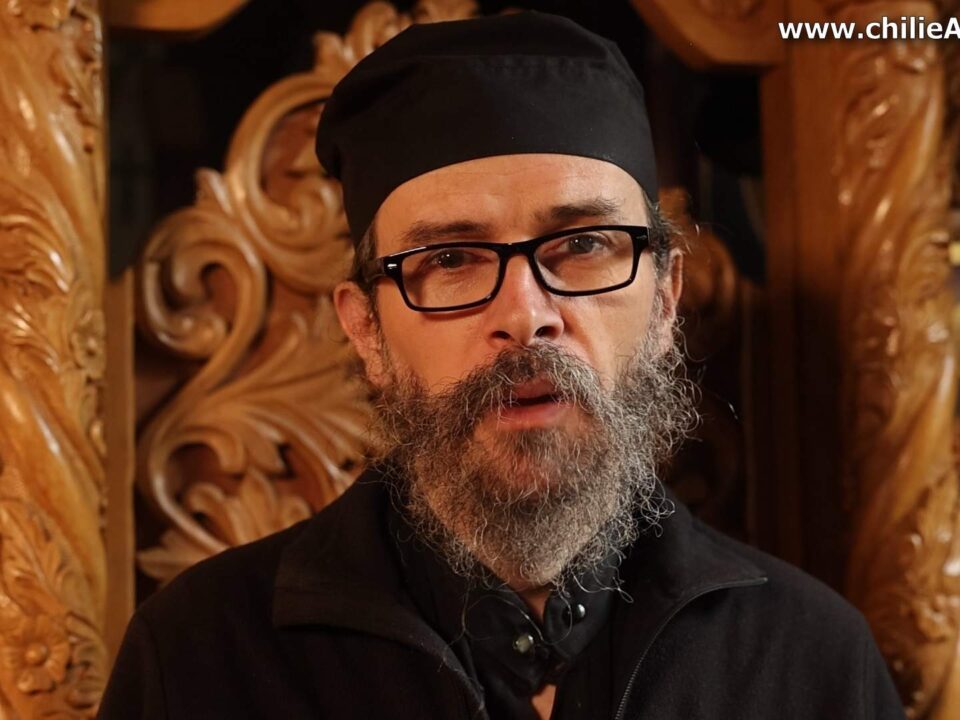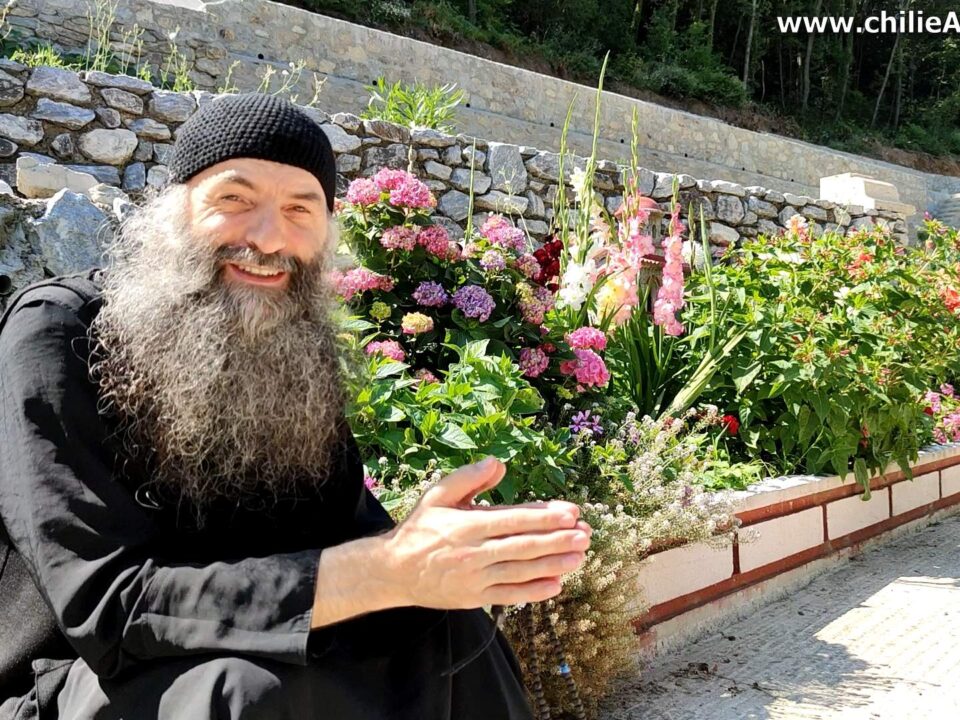
Obedience and Politics – Father Theologos
10 August 2022
The Mother of God as an Example for Us – Father Theologos
14 August 2022Watch a talk by Father Pimen Vlad in which he tells us some things regarding his itinerary through Romania as well as about the Mother of God in whose fast we are.
Enjoy!
Look dear ones, we are seeing each other again! But from a completely different place. I think you already know that I have been in Romania for awhile, and because Father Theologos always says to me, “Send me another recording, something to upload because people are asking” I thought, let’s record something between other things, because I haven’t really succeeded so far. And now in the moment I thought of it. You can see that I’m here somewhere in a field. Right in my village, at the parental home, I came for a walk out here in the field, and I thought to put the phone down on two stones, sit on the grass and tell you a few words. Since I don’t really get a chance to, because here in Romania things are a little busier.
What can be done… with chores… with many places, and with the people who always want to talk, to meet. You can see behind me… I don’t know how much you can see because of how I put my phone, behind me there is a little hill further away, I have spoke to you before about where we used to go sledding, with the skis… That is, all these fields are the places of my childhood. And now I still like it here; I have a little way I walk in the evening when I manage to come to the area of my parental home. And I’m right on a little road where people have their fields. Each one with corn, potatoes, wheat, everything is done here.
What can I tell you — just yesterday and the day before, these two days I went to the monastery of Sihăstria. It was the feast of the Venerable Theodora of Sihla. And you know that at the monastery, at Sihăstria, there is the great cathedral built in honor of the Venerable Theodora. And whenever I find myself in the country on this day when [her feast day] is celebrated, I always go to the monastery, to Sihăstria. Because a part of my heart is there so to speak. That’s where I started my life as a monk, that is where I was made a monk, that’s where the roots are from. And I lived alongside the elders there: Father Cleopas and many elders with holy lives. And that’s how it was this time too. I enjoyed very much the vigil for the Venerable Theodora, on the second day the Divine Liturgy; those who were there know because I met so many, that is, I barely had time to take a breath. [I met] maybe even thousands of people. I managed, as they say, to exchange a word, a look, with those whom I met.
We have beautiful people, wonderful people! Faithful people. What can I say, I really enjoyed this meeting with so many thousands of people. I actually met and embraced thousands of people at the monastery at Sihăstria, and after the Divine Liturgy I also went up to Sihla. And it was the same there, for a few minutes, at Sihla I caught the procession that goes to the cave and back, with the icon and everything. His Grace Seraphim was there. At Sihăstria there was the metropolitan, His Eminence Theophan, there was also His Grace Casian from Galați, and His Grace Damaschin Dorneanu and His Grace Veniamin from Northern Bessarabia.
And… I really enjoyed everything that was at Sihăstria. After that [we went] to the cemetery all together (after the meal was served) to the elders who are there in the cemetery. There was a beautiful Trisagion held there. I rejoiced at all these beautiful moments. I’ll send some photos to Father Theologos to add them from the Monastery of Sihăstria for those who have not been, because I took some photographs to to remember. Likewise at Sihla, at the cave [it was] very beautiful.
As you know, Venerable Theodora struggled. At the very beginning, she was in the world, married. After that she wished for the monastic life. She entered the monastery, she and her husband. She stayed somewhere around Buzău, in that area until the Turks came there, – when it was during that time – and after that she retired to this area of Moldova and struggled for many years in this cave that is located at Sihla monastery. Sihla, before, used to be a skete. In ’88 to ’89 I stayed [there] for two years, at the beginning, as a beginner. It was a hermitic place, there was only the church and an old house. Now more has been done there, a larger community has gathered.
Yes. And that’s where Venerable Theodora struggled, for many years, in that cave, until it was God’s will for her to be discovered; because from Sihăstria Monastery the fathers could see birds coming, taking food, bread, different things and flying in the forest. [The birds were taking food to St. Theodora] They realized that they were taking it somewhere, that they weren’t eating it. They followed the birds and reached her cave. That’s how it was God’s disposition for her to be discovered. They talked to her and then she asked them to send a spiritual father to hear her confession and to give her Communion. And in this way she confessed, she Communed and went to the Lord. The Venerable Theodora.
And her husband also became monk, and later he was also ordained priest and had a holy life. I think, Eleftherios was his name, hieromonk Eleftherios. Yes. Great saints who lived in our mountains.
I was looking a little further, also in the field there was a great black and white shepherd dog coming, I see that he has stopped now, he is a huge, shepherd dog, I was thinking, is he coming to talk? Or have I entered his territory? But I see that for now he has stopped and is looking towards me. He sees that I’m talking and doesn’t know what it’s about. We will see, if he comes I hope he has peaceful thoughts.
Because there are people here who have sheep, and so there are also big dogs. And another thing: let us not forget that we are in the fast of the Mother of God, the fast of the Dormition of the Mother of God. You see that it’s a bit of a harsher fast, we can say. In what way harsher? It resembles Lent. The fast of the Dormition of the Mother of God. It’s not long. Two weeks, but you can only eat fish for the Transfiguration, only once. Other than that, except for Saturday and Sunday, it is tried, if it is possible to eat without oil. For the Mother of God, in her honor and for our benefit. Because we all know that the Mother of God is our connection to Heaven. Yes, my dear ones! The Mother of God… we could say that without the Mother of God, it’s not that we would be a lot poorer, but we would be poor altogether. The Mother of God, [it is] thanks to her the Savior was incarnated. And He brought us our salvation. And you see, after her living here on earth, after the crucifixion, burial, resurrection, ascension of the Savior, after the descent of the Holy Spirit, she lived for years on Earth.
She also did mission work. She was taken by the Holy Apostle and Evangelist John to his house and after that she was with him in many places, even in Ephesus, in Turkey — there is the house of the Mother of God. She went there along with the Holy Apostle and Evangelist John. And as you know, she reached Holy Mount Athos as well, and when it was time for the Mother of God to leave, all the apostles gathered together. You realize, they were scattered around the world, every one of them was away. There were no phones, internet, no human ways of connecting. And yet, how God worked! Because He knew that the Mother of God wanted to see the apostles, and first of all they wanted to see her before her departure. He took each of them on a cloud from all over the world and brought them in the twinkling of an eye to Jerusalem, to say goodbye to the Mother of God before she left.
Only not Holy Apostle Thomas… we see that even in the beginning he was the one who, through his unbelief, we are assured of the resurrection of the Savior. Because he put his hand into the rib of the Savior. To be assured, now it was the same; When the Mother of God was about to leave, she said goodbye to everyone, laid down nicely, and she fell asleep. Well, Holy Apostle Thomas was not there. They put the Mother of God in her tomb, those of you who have made it to Jerusalem, [have seen] the tomb of the Mother of God. And after laying her in the tomb, Holy Apostle Thomas arrived that is, the cloud brought him, but later. And as the cloud brought him, he met the Mother of God as she went to Heaven! And then, what did the Mother of God do? To give him joy somehow, because he had not been there, she threw her sash to him, to the Holy Apostle Thomas, sash which has remained with us on earth, as an assurance that she is indeed the Mother of God, he saw her too.
And after that, when Holy Apostle Thomas arrived, he said, “I want to see the tomb of the Mother of God!” And they opened up the tomb and they did not find the Mother of God there anymore. So her body was no longer there. How could the body of the Mother of God know corruption like our mortal bodies do since she gave birth to God, the Savior! So she went through death, because she had to go through death, but after that, she was taken with her body to heaven, that is, we can say that her body became a spiritual body, just like that of the Savior after the resurrection. He took her to Heaven! Completely. The Mother of God whom we have as an intercessor for us!
You see how many wonderful things, let us never forget the Mother of God, how good she is, how merciful, how loving she is. And she never leaves us. It is enough to shout to her with faith. And now, because there’s a little bit of the fast left, try a little [to fast], even those who haven’t kept the fast, just a little bit, for the Mother of God, because she is the best and most merciful mother. Come, let’s try a little bit! And those who did not confess, try to confess. [Try] a little like this, for yourselves, because it is useful to you, it’s not that the Mother of God would need such a thing. But the Mother of God rejoices. It’s like the mother who rejoices when she sees her children trying to do good, trying to be kind, trying to change their lives a little.
So come, let’s try too, my dear ones, to be a little kinder and to turn our heart, our mind a little towards the Mother of God. Let us say a little prayer as best we can, each one of us. In the evening, in our little corner, to shout to the Mother of God to help us. And of course, let us truly celebrate her feast day! As there is, on the eve of it, the service of the Lamentations of the Dormition of the Mother of God, and then the feast of the Mother of God [let’s celebrate] with honor and with love. Because the Mother of God is the mother of all of us.
May the Mother of God help us, and keep us always under her protection! Lord help us!
Online commemoration lists and donations
May the Lord help us!
Online Commemoration Lists and Donations
May the Lord help us!
If you have a bank card and wish to send commemoration lists and donations online using your card, and/or to support our philanthropic activity, including this site, please fill out the form below to make a small donation. The form is secure – we use Stripe for payment processing – a world leader in this field. We do not collect your personal data.
If you do not have a card, or do not wish to use it, visit the webpage for Online Donations and Commemoration Lists.
We will pray for your loved ones! (Please do not include inessential details like wishes, degree of kinship, introductions etc. JUST the name!)
Especially for recurring commemoration lists, we ask that you please keep them to under 20 names long. If you include a member of the family, we add “and for their families.”

Pomelnice online și donații
Doamne ajută!
Dacă aveți un card și doriți să trimiteți pomelnice online și donații folosind cardul dumneavoastră, sau/și să susțineți activitatea noastră filantropică, inclusiv acest site, vă rugăm să introduceți datele necesare mai jos pentru a face o mică donație. Forma este sigură – procesatorul de carduri este Stripe – leader mondial în acest domeniu. Nu colectăm datele dvs. personale.
Dacă nu aveți card sau nu doriți să-l folosiți, accesați Pagina de donații și Pomelnice online .
Ne rugăm pentru cei dragi ai dumneavoastră! (vă rugăm nu introduceți detalii neesențiale precum dorințe, grade de rudenie, introduceri etc. Treceți DOAR numele!)
Mai ales pentru pomelnicele recurente, vă rugăm să păstrați pomelnicele sub 20 de nume. Dacă puneți un membru al familiei, noi adăugăm „și familiile lor”.
Dumnezeu să vă răsplătească dragostea!







